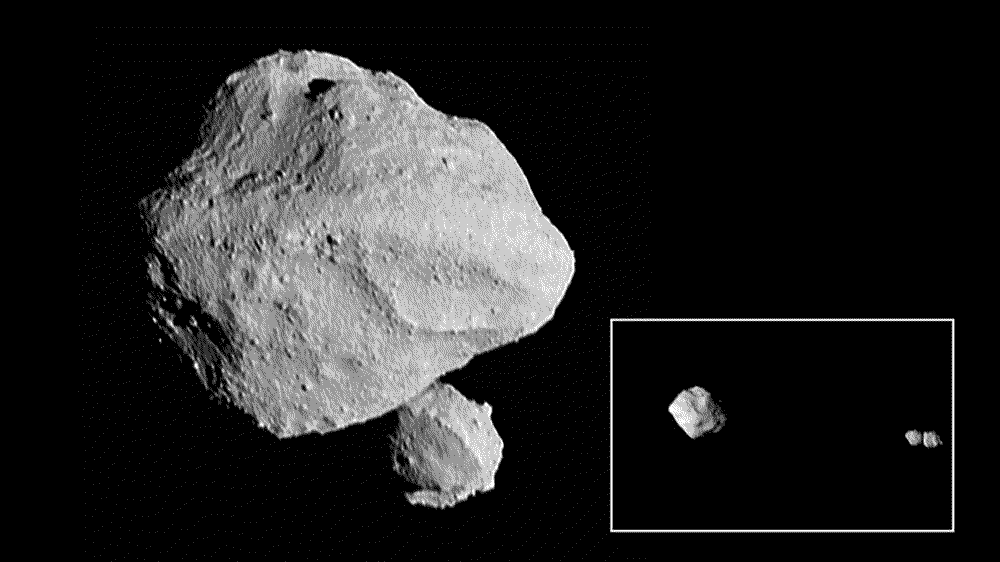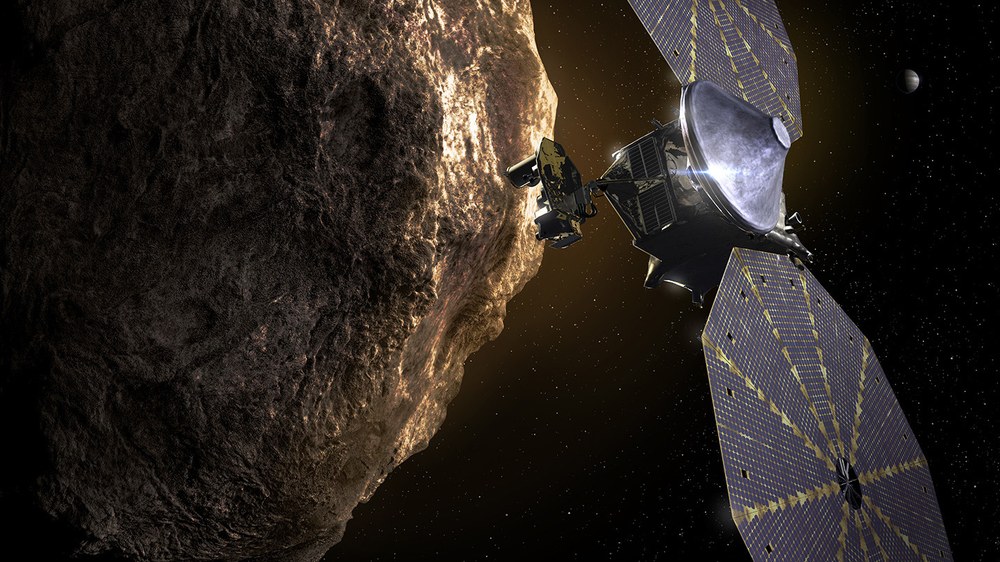DLRmagazine article – A journey into the realm of the Trojans
NASA's remarkable asteroid mission Lucy (DLRmagazine 168, September 2021).

NASA/Goddard/SwRI/Johns Hopkins APL/NOIRLab

Southwest Research Institute

First a small surprise and then a big one: when NASA's Lucy space probe transmitted the first images to Earth after its flyby of the small asteroid Dinkinesh on 1 November 2023, it revealed a moon behind the 720-metre asteroid. The science team had previously considered the possibility that Dinkinesh might have a companion, as the light curves recorded using ground-based telescopes showed an irregularity that pointed to this. Now, however, the satellite was real. Then came more photos, and when the team examined them they were astonished: the Dinkinesh moon is made up of two parts, a so-called contact binary. The two touching satellites have diameters of 210 and 230 metres and orbit Dinkinesh at a distance of 3.1 kilometres in almost 53 hours. The German Aerospace Center (Deutsches Zentrum für Luft- und Raumfahrt; DLR) is involved in the discovery.

Video of Lucy's flyby of (152830) Dinkinesh
Your consent to the storage of data ('cookies') is required for the playback of this video on Quickchannel.com. You can view and change your current data storage settings at any time under privacy.
NASA/Goddard/SwRI/Johns Hopkins APL/NOIRLab
"The Lucy science team has been collecting data on Dinkinesh using telescopes since January 2023. At that point, Dinkinesh was added to our list of targets," said Simone Marchi, Deputy Project Investigator for the NASA Lucy mission; at the Southwest Reasearch Institute in Boulder, Colorado (USA). "We thought we had a pretty good idea of what Dinkinesh would look like thanks to the telescope data. But we were then thrilled to have made so many unexpected discoveries!" Dinkinesh's companion has now been named (152830) Dinkinesh I Selam by the International Astronomical Union (IAU), at the suggestion of the Lucy team. "This is the first time that such a configuration has been observed," says a delighted Stefano Mottola from the DLR Institute of Planetary Research, a member of the Lucy science team. Together with Frank Preusker, also from the DLR Institute of Planetary Research, he is responsible for the photogrammetric analysis of the image data and the calculation of digital terrain models to determine the shape of the three observed bodies.
In preparation for the flyby, Mottola intensively analysed the light curves of the asteroid, which rotates around its axis and reflects the sunlight to varying degrees. "The shape of these light curves was unusual for a normally rotating body," Mottola continues. "A companion of Dinkinesh was therefore conceivable. But the fact that it would turn out to be a double body, a 'contact binary', came as a total surprise." The results of the Lucy flyby have been published in the scientific journal Nature. Lucy is a mission in NASA's Discovery programme, which was launched on 16 October 2021. Its main targets are asteroids in Jupiter's orbit, known as Trojans, which precede or follow the planet by 60 degrees at two libration or Lagrange points. Several of these will initially be studied in 2027 and 2028, and will be observed again from 2033 onwards. The mission is named after a three-million-year-old fossilised skeleton that was unearthed in Ethiopia in 1974.
No asteroid flyby was originally planned for 2023. However, Raphael Marschall, a member of the Lucy team, searched intensively for a flyby opportunity in the inner main asteroid belt and succeeded in January 2023. The asteroid, then known as 199 VD57, was given the Amharic name Dinkinesh ('You are marvellous') in the same year and would enable a close flyby at a distance of 431 kilometres with minor changes to its path. Above all, it could take place in a flight geometry that would be similar to the planned asteroid flybys during the actual mission with the Trojans of Jupiter. This opened up the possibility of testing the terminal tracking system, in other words the final, autonomous determination of the distance to the asteroids and thus optimised targeting. Lucy's instruments could also be subjected to a real experimental test. Both the scientific and technical objectives were achieved in full.
The Lucy flyby took place at a speed of 4.5 kilometres per second relative to Dinkinesh at a distance of around 470 million kilometres from Earth. Due to the long data travel time to Earth of 26 minutes, it was not possible to control the manoeuvres in real time. All manoeuvres were programmed in advance and ran fully automatically. The 48 images acquired with the L'LORRI camera show details of between 10 and 2.2 metres per pixel.
Dinkinesh is a surprisingly complex small body. The most striking feature is a groove that extends on both sides of the equator towards the poles on its photographed side, as well as a bulging ridge along the equator. The elongated trough is interpreted as visible evidence of the origin of the accompanying binary bodies. The missing material was torn out during a structural break of Dinkinesh, initially forming a ring around the planetoid from which the two sub-bodies of Selam emerged. The bulge along the equator could have been caused by other material that fell back out of the ring.
However, in the recently published paper, the Lucy team also discusses variants of this scenario. All explanations are based on a special effect involving small asteroids of less than five kilometres in diameter: the so-called YORP effect. It is named after the initials of the scientists Yarkovsky, O'Keefe, Radzievskii and Paddack, who predicted, calculated and later measured and demonstrated the concept: Sunlight heats the surface and thus stimulates the emission of thermal radiation. The photons of the infrared radiation emitted – even in the 'asteroid night' – exert a small momentum on a surface despite their tiny mass, which causes changes in the orientation of the rotation axis and/or the rotation speed over many millions of years. The YORP effect is thought to play a significant role in the formation of small asteroid companions – as could also have been the case with the formation of Selam.
Dinkinesh belongs to the S-type class of asteroids, which have a significantly higher proportion of iron- and magnesium-containing silicate minerals compared to the much more common, carbon-rich C-type asteroids. Around 17 percent of all asteroids belong to the S type. They are dominant in the inner part of the asteroid belt, around 100 million kilometres beyond the orbit of Mars, and become rarer the further they are from the Sun. Type S asteroids have a relatively high density of three grams per cubic centimetre on average. The density of Dinkinesh was calculated to be 2.4 grams per cubic centimetre, indicating that the asteroid is porous and has voids of up to a quarter of its total volume between its particles.
Harold F. Levison et al.: A Contact Binary Satellite of the Asteroid (152830) Dinkinesh. Nature (2023) DOI: 10.1038/s41586-024-07378-0
